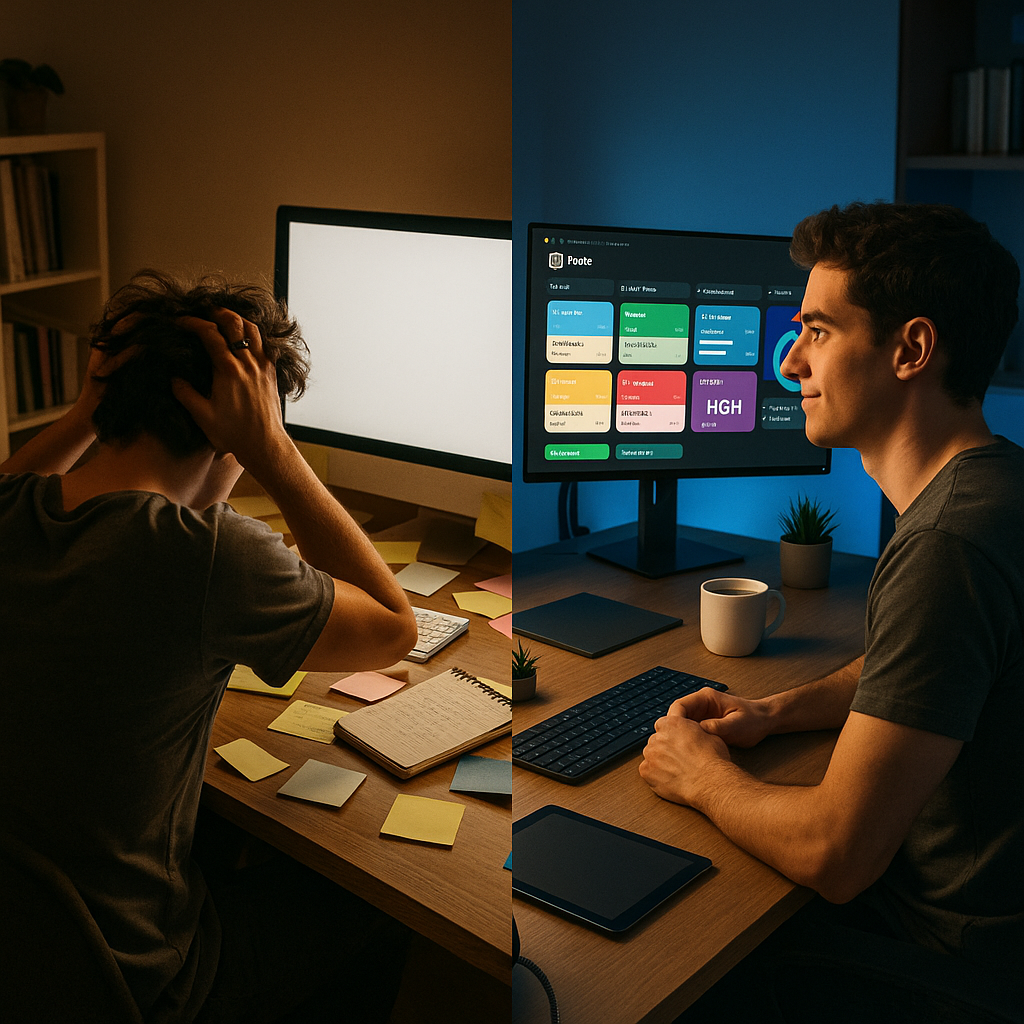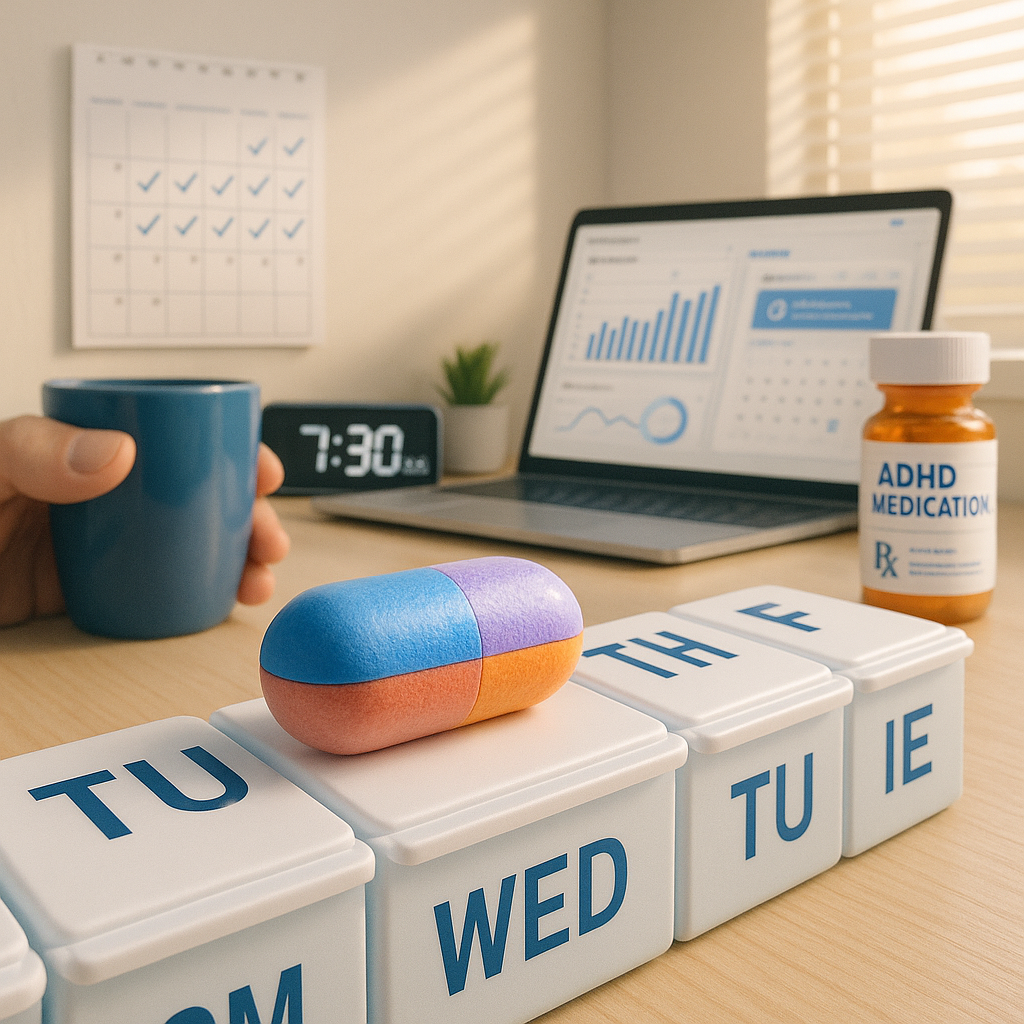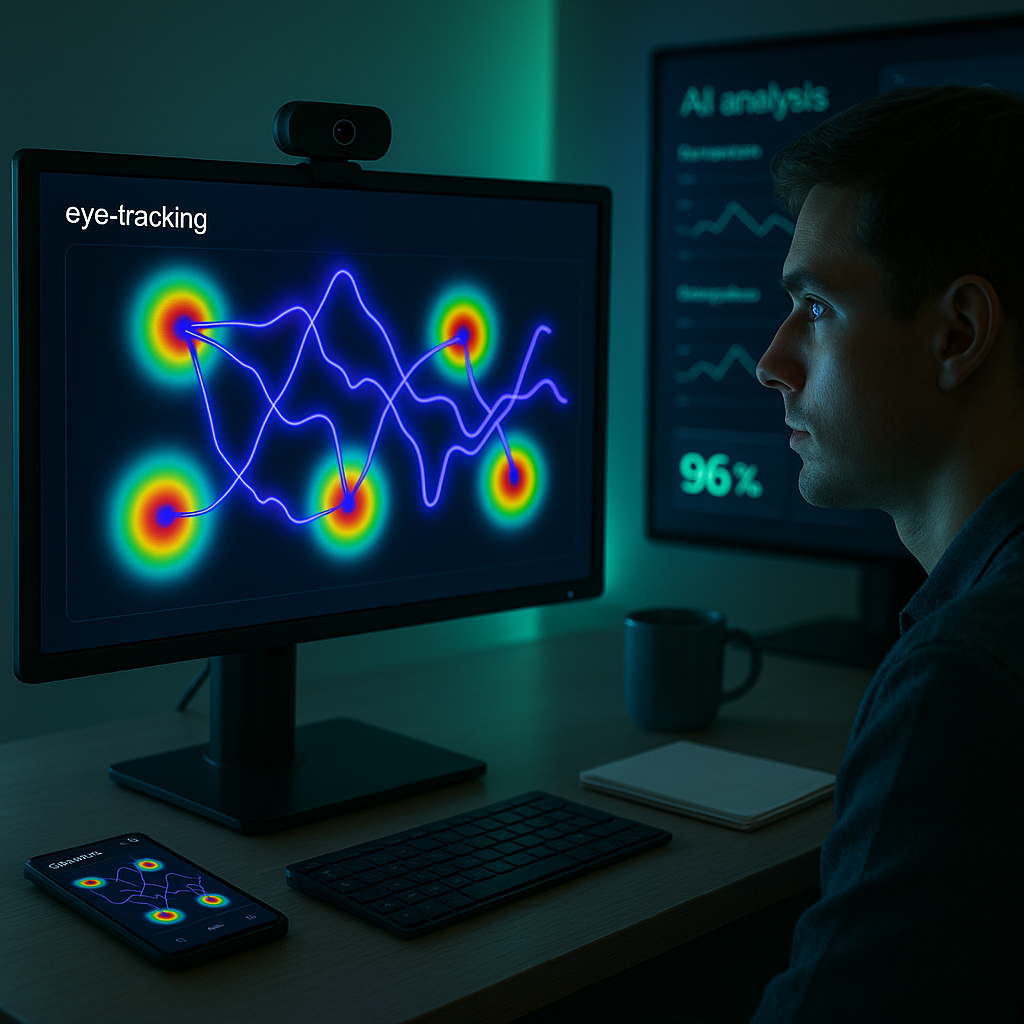Key Takeaways
- AI dashboards in Notion are revolutionizing how neurodivergent minds set, track, and achieve their goals. For professionals and creatives with ADHD, these systems do more than organize tasks; they translate chaos into clarity, making productivity feel personal and progress unmistakably visible. Here’s what you should know to unlock their full capabilities.
- Visual dashboards transform ADHD overwhelm into clarity. Color-coded, customizable setups inside Notion help streamline scattered thoughts and tasks into a focused, easy-to-navigate command center.
- AI-powered goal tracking eliminates manual barriers. By providing smart prompts, progress monitoring, and automated reminders, AI dashboards significantly reduce mental effort, enabling you to stay on track with less strain.
- Build feedback loops that drive motivation. AI dashboards actively analyze your productivity data, offering real-time tweaks, encouraging nudges, and actionable insights tailored to ADHD work patterns. This means your system not only supports you but learns and adapts alongside you.
- Integrate life, work, and wellness seamlessly. Notion dashboards bring together projects, appointments, habits, and self-care prompts into a single space, allowing holistic management and cutting down on app-jumping (and lost focus).
- Let your dashboard evolve with your mind. As your routines shift and you discover what works, Notion dashboards flex and scale with your ambitions, without excess complexity or clutter.
- Transform shame into celebration by making wins visible. Whether you’re stacking habits or completing micro-tasks, AI dashboards highlight your progress. This visibility helps replace guilt with pride, offering a powerful antidote to ADHD’s “never enough” feeling.
Mastering dashboard ADHD strategies in Notion means building a productivity system that’s as unique and dynamic as your mind. Sustainable progress is possible. And it can feel fully authentic, not forced. Coming up, we’ll walk you through step-by-step setups, highlight top AI integrations, and share how to craft a system you’ll genuinely want to use.
Introduction
For many with ADHD, staring down a sea of sticky notes or flicking between a tangled web of digital lists can make goal-setting feel impossible. What if your productivity system could actually meet your brain where it thrives? Visually, intuitively, and minus the avalanche of manual planning. With AI-powered dashboards in Notion, traditional methods are rapidly giving way to new possibilities that turn chaos into clarity, making every task, deadline, and small win visible in one ADHD-optimized space.
Forgotten priorities and haphazard progress no longer have to be the norm. Using dashboard ADHD strategies in combination with AI, you’ll discover how to stay meaningfully organized, merge work and wellness, and transform overwhelm into sustainable, authentic momentum. Let’s explore how these next-gen Notion dashboards can evolve with you and make your progress truly impossible to overlook.
Understanding ADHD Challenges in Goal Tracking
Before diving into solutions, it’s important to understand the unique obstacles ADHD brings to goal management. These challenges shape why conventional productivity tools frequently miss the mark, highlighting what a tailored system must provide.
The Executive Function Gap
One of the most significant hurdles for individuals with ADHD is difficulty with executive functions. This isn’t just about working harder. It’s about fundamental neurological differences in how the ADHD brain operates day to day.
People with ADHD may experience:
- Short-term memory gaps that make juggling multiple tasks or objectives overwhelming
- Time blindness that skews perception of deadlines and how long tasks take
- Hesitancy or paralysis in starting new tasks due to initiation barriers
- Fluctuations in focus, especially for tasks that aren’t inherently stimulating
- Trouble breaking big goals into actionable, sequenced steps
These executive function challenges often turn standard productivity approaches into cycles of frustration. As one ADHD business coach put it, “My clients don’t lack ambition, just systems that match how their brains work.” Effective support must bridge this gap with tailored strategies, not one-size-fits-all instructions.
The Visibility Problem
ADHD isn’t just a matter of distractibility. There’s a core issue around information visibility. For neurodivergent brains, “out of sight” becomes “out of mind” surprisingly fast, making standard digital or paper planners unreliable over time.
Traditional goal trackers stumble for people with ADHD because they:
- Depend on perfect recall or repeated checking
- Hide critical details behind menus, tabs, or deep pages
- Demand manual updates that become mental barriers in themselves
- Lack visual interest to spark engagement and curb forgetfulness
- Miss opportunities for positive, dopamine-boosting feedback loops
Research continues to affirm these challenges. A study in the Journal of Attention Disorders, for instance, found that providing visual cues increased task completion among ADHD participants by 42% over plain-text reminders.
That’s why physical solutions like sticky notes or dry-erase boards remain so popular. They deliver maximum visibility, even if they lack the analytics and scalability of digital systems. The ideal productivity dashboard, then, must combine high visibility, customization, and automation. This is precisely the realm where Notion dashboards enhanced by AI now excel.
Moving forward, we won’t aim to “fix” ADHD. Instead, the focus is to create systems that elevate neurodivergent strengths while providing support exactly where it’s needed.
Why AI Dashboards Work for the ADHD Brain
Transitioning from challenges to solutions, let’s look at the science and practicality behind why AI-powered dashboards are uniquely effective for ADHD workflows.
Visual Organization and Dopamine Triggers
ADHD brains are hardwired to respond better to visual cues and quick dopamine hits. It’s a reality that smart dashboard design can harness to serious advantage.
Here’s how Notion dashboards can put these principles to work:
- Color-coding instantly signals priority or project area, clarifying what matters at a glance
- Progress bars and completion metrics visually reinforce success and spark satisfaction
- Real-time charts and graphs turn distant goals into immediately understandable visuals
- Achievement badges or celebratory graphics strengthen reward loops and reinforce momentum
These visual features aren’t just cosmetic; they act as “external scaffolding” (a term coined by Dr. Russell Barkley) to help organize thinking and action when internal executive function is taxed.
As one graphic designer with ADHD shares, “My Notion dashboard feels like my external brain. Every time I check something off or see my progress chart, I get a little dopamine buzz that makes it easier to keep going.”
Reducing Decision Fatigue
For those with ADHD, every small decision adds up, leading to a rapid drain on available focus and willpower. AI dashboards excel at minimizing this decision fatigue, letting you reserve those resources for real creation and deep work.
Effective AI dashboards achieve this by:
- Automating what gets shown next, so you aren’t flooded by irrelevant options
- Picking out top priorities, deadlines, or “hot tasks” and surfacing them automatically
- Filtering displays so that you see only what’s useful for your current context, whether it’s a morning routine, urgent work project, or winding down at the end of the day
- Providing templates or recommended workflows, so you never start from a blank slate
- Recommending actions or routines based on your prior engagement patterns
Research published in the Journal of Experimental Psychology found that reducing choices increased task completion rates by up to 28% in people with attention challenges. AI dashboards allow the ADHD brain to sidestep overload and move directly into action.
With these foundations in mind, we can now break down what makes an ADHD-friendly dashboard both effective and personal.
Key Components of an Effective ADHD Dashboard
Building a productivity dashboard that actually sticks requires more than just structure. It demands specific features designed for how neurodivergent minds function and evolve.
Essential Dashboard Elements
The most impactful Notion dashboards for ADHD incorporate several must-have features:
- Single-view goal tracker: All active goals and their progress visualized in one consolidated space, so nothing slips out of sight (or mind).
- Time-horizon toggles: Quick switches between daily, weekly, monthly, and quarterly views to combat time blindness and keep both now and next in focus.
- Priority indicators: Bold colors, icons, or positioning to immediately highlight what needs attention first, reducing decision paralysis.
- Energy matching: Tasks tagged by the level of mental capacity they require. This makes it easier to match work with how you actually feel, not just what’s on the calendar.
- Reward systems: Built-in celebration moments or points/bragging rights for meeting milestones. Dopamine-driven feedback ignites progress, even on low-motivation days.
These building blocks shift dashboards from mere tracking tools into dynamic systems for decision-making and motivation. As a software developer with ADHD puts it, “My dashboard tells me what matters most, right now, without me having to figure it out from scratch every time.”
Customization for Different ADHD Types
No two ADHD minds are identical. Different presentations (inattentive, hyperactive-impulsive, combined) often require tailored dashboard solutions to stay effective across changing days or moods:
Predominantly Inattentive:
- Enhanced notifications and visual pop-ups
- Oversized, simple layouts to avoid overwhelm
- Timed focus-block visualizations
- Detailed progress logs for encouragement
- Built-in session timers
Predominantly Hyperactive-Impulsive:
- Rapid capture tools for bursts of ideas
- Clear, physical checklists for task satisfaction
- Visual “waiting on” trackers to avoid jumping prematurely into new projects
- Reminders built around movement or activity outlets
- Celebration graphics or sound cues for finishing tasks
Combined Type:
- Flexible dashboard views that can toggle between minimal and detailed
- Visual hierarchies to guide shifting attention
- Access to both granular metrics and broad overviews
- Multiple visualization styles to match executive needs
- Scheduled focus breaks and quick resets
Notion’s flexibility means you can have all these features ready, toggling between modes or dashboard setups as your needs and energy shift. One entrepreneur summed it up: “Some days I need the ‘easy mode’ view, other days I flip to analytics to power through. It’s like a dashboard that learns my moods.”
Next, let’s examine how integrating AI takes these personalized dashboards from good to truly groundbreaking.
AI Integration: Making Dashboards Dynamic
AI isn’t just a buzzword here. When thoughtfully applied, it takes Notion dashboards from static to proactive, constantly learning and adapting to your unique work patterns and preferences.
How AI Enhances Notion Organization
AI unlocks capabilities that manual dashboards can’t match, including:
- Predictive prioritization: AI quickly analyzes your past behaviors (like task completion rates or missed deadlines), offering realistic suggestions on what to tackle next and when. This helps with time estimation challenges.
- Adaptive displays: Smart algorithms learn which dashboard elements engage you most, then adjust what’s shown to reduce clutter and boost relevance.
- Natural language quick capture: AI lets you add ideas, to-dos, or notes in plain English (or your preferred communication style), lowering the barrier to staying organized.
- Insightful pattern recognition: By monitoring your routines, AI points out peak productivity times, recurring blockers, and strengths. It turns raw data into actionable insights for self-improvement.
- Automated linking: AI can spot relationships between projects, tasks, or notes, connecting dots that support associative thinking and prevent information silos.
This level of nuance addresses a common pitfall for those with ADHD: investing heavily in organization tools, only to abandon them when upkeep becomes overwhelming. As a marketing consultant observed, “AI is like having a virtual assistant that keeps my dashboard fresh and useful, without requiring constant manual updates.”
Automations That Reduce Friction
The most powerful productivity systems continually work to reduce friction, especially vital for neurodivergent users. AI-fueled automations can include:
- Personalized reminders that ping you when you’re statistically most likely to finish a task
- One-click quick capture tools for fleeting ideas or urgent to-dos
- Streak trackers and momentum visualizations to celebrate consistency
- Automatic surfacing of overdue or high-priority goals, so nothing slips through
- Gentle motivation boosts or “you’ve got this” nudges during low-motivation slumps
In professional fields like finance, AI-powered dashboards flag key deadlines and suggest optimal review times based on your cognitive patterns. In the legal sector, contract review tasks are prioritized based on urgency and your past workflow bottlenecks. For educators, AI tracks lesson prep and automates student follow-up reminders, adjusting frequency to your attention rhythms. In healthcare, clinicians are prompted to complete notes or follow up with patients at prime focus intervals, boosting compliance and reducing the risk of missed steps.
Automations like these not only combat shame and inertia, but make the dashboard an intuitive, adaptive part of ordinary life, reducing recurring frustration and supercharging confidence.
Conclusion
Embracing AI dashboards in Notion does more than organize tasks. It redefines how neurodivergent professionals, solopreneurs, and creatives with ADHD approach goal-setting and productivity. By seamlessly combining visual clarity, motivating feedback, and self-adjusting automation, these dashboards finally bridge the persistent gaps in executive function and visibility that undermine traditional methods. Key features, such as progress visualization, personalized priority cues, and energy-aware task planning, work in harmony to spark sustainable motivation and daily momentum. AI ensures the system learns with you, adapting as your needs evolve.
Importantly, this approach does not aim to “normalize” neurodivergence. Instead, it amplifies and celebrates your unique strengths, transforming deep-rooted struggles into genuine leverage for growth. In industries as varied as business, education, marketing, finance, and healthcare, adaptive dashboards are already helping professionals turn complexity into clarity.
Looking to the future, the true advantage will belong to those who go beyond adopting these tools to actively shape them around their own patterns, ambitions, and ways of thinking. Whether you’re building a business, expanding your creative horizons, or seeking balance in a fast-moving world, the real opportunity is not simply to keep pace with technology but to harness it as a partner in unlocking your rare brilliance. The question isn’t if these dynamic dashboards will transform how you work; it’s how creatively you’ll wield them to showcase and scale your one-of-a-kind potential.





Leave a Reply